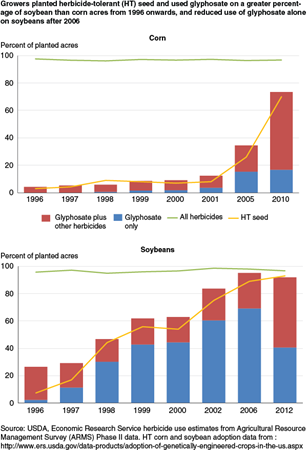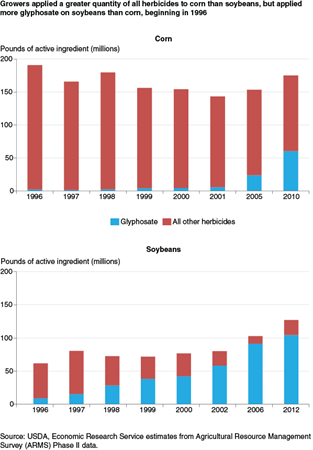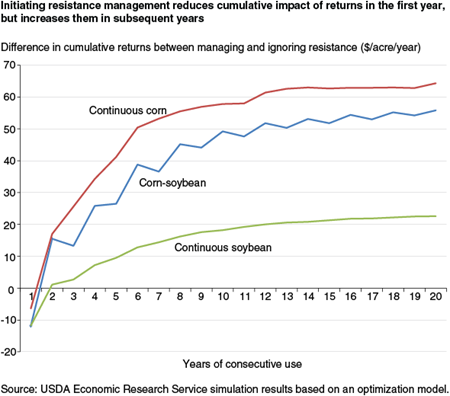Managing Glyphosate Resistance May Sustain Its Efficacy and Increase Long-Term Returns to Corn and Soybean Production

Highlights:
-
Widespread use of glyphosate on major crops, particularly soybeans, has contributed to the evolution of weed resistance to this herbicide.
-
Managing glyphosate resistance is more cost-effective than ignoring resistance. In the cases of continuous corn cultivation, corn-soybean rotation, or continuous soybean cultivation, the cumulative impact of returns are higher after about 2 consecutive years of managing resistance instead of ignoring it.
-
The higher returns obtained by farmers who manage resistance compared with the returns of farmers who ignore resistance are greater when neighboring farmers also manage resistance.
Glyphosate—known by many trade names, including Roundup—has been the most widely used pesticide in the United States since 2001. It effectively controls many weed species, and it generally costs less than the herbicides it replaced. Crop producers can spray entire fields planted with genetically engineered, glyphosate-tolerant (GT) varieties of corn, cotton, soybeans, and other crops, killing the weeds but not the crops. This practice makes it easier to manage weeds using less tillage, which can help reduce soil erosion as well as improve soil quality and water conservation.
However, glyphosate is becoming less effective as weed resistance mounts—14 glyphosate-resistant (GR) weed species have been documented in U.S. crop-production areas. GR weeds can reduce crop yields and increase weed-control costs, and recent surveys suggest that the amount of affected cropland is increasing.
Sole reliance on glyphosate by many producers is believed to be the primary factor in the evolution of weed resistance to glyphosate. Using glyphosate as the only weed control tactic can select for resistance to this herbicide by controlling susceptible weeds while allowing more resistant weeds to survive, propagate, and spread. Using herbicides with different mechanisms of action, however, and rotating their use over time can result in fewer herbicide-resistant weeds. This feature discusses the role of current herbicide use patterns in the evolution of glyphosate-resistant weeds, the effects of glyphosate-resistant weeds and resistance management on returns to corn and soybean production, and incentives to encourage resistance management.
Glyphosate Use Is More Widespread in Soybean Production Than in Corn Production
Since the commercial introduction of GT crops in 1996, U.S. producers have planted GT varieties and applied glyphosate on more soybean acres than corn acres. The proportion of acreage planted with herbicide-tolerant (primarily GT) varieties reached 93 percent for soybeans and 85 percent for corn in 2013. The share of soybean acres treated with glyphosate (alone or with other herbicides) increased from 25 percent in 1996 to more than 90 percent in 2006-2012, while the share of corn acres treated increased steadily from 4 percent of acres in 1996 to 73 percent in 2010, as the use of other herbicides decreased. While a greater quantity of herbicide active ingredient was applied to corn than to soybeans, herbicides other than glyphosate accounted for the majority of the herbicide applied to corn. As a result of these differences in herbicide use patterns, more glyphosate (in pounds of active ingredient) was applied to soybean fields than to corn fields. Further, tillage—which controls weeds without promoting herbicide resistance—was used on a greater percentage of corn than soybean acreage, whereas no-till was used on a greater percentage of soybean acreage.
The fact that a greater share of soybean acres than corn acres was treated with glyphosate alone could be an important factor in the greater prevalence of glyphosate-resistant weeds in soybean production. However, the share of soybean acreage treated with glyphosate alone declined from 2006 to 2012, while the share treated with glyphosate plus other herbicides increased, perhaps in response to the increased prevalence of glyphosate-resistant weeds.
There is an important reason why GT soybean varieties have been adopted more rapidly than GT corn varieties and why more glyphosate has been used on soybeans than on corn in the United States. Weed management in corn fields involves not only glyphosate, but also other inexpensive herbicides, such as atrazine. In contrast, weeds in many soybean fields are managed with glyphosate alone, because the next best alternative herbicides for soybean fields are more expensive, less effective, and/or can cause significant injury to soybean plants.
Glyphosate-Resistant Weeds Are More Prevalent on Soybean Acres Than on Corn Acres
Glyphosate use in soybean production has resulted in the spread of GR weeds more than its use in corn production. Recent data obtained by the Agricultural and Resources Management Survey (ARMS), managed jointly by USDA’s Economic Research Service and National Agricultural Statistics Service, show that growers reported GR-weed infestations on 5.6 percent of corn acres in 2010, with the Corn Belt and Northern Plains accounting for the majority of infested corn acres. In contrast, growers reported a decline in the effectiveness of glyphosate in controlling weeds on almost 44 percent of soybean acres in 2012; the majority of these acres were also in the Corn Belt and Northern Plains. However, growers reported GR weeds and declines in glyphosate effectiveness on greater percentages of both corn and soybean acres in the South than in the North.
Glyphosate Resistance Increases Costs and Reduces Yields and Returns
An ERS study used statistical procedures to identify growers in the 2010 and 2012 ARMS surveys with similar characteristics and then estimate the average impact of GR weeds or reduced glyphosate effectiveness on yields, production costs, and returns. The study found that corn producers who reported GR weeds and soybean producers who reported reduced glyphosate effectiveness realized lower returns than similar corn and soybean producers who did not. For example, the annual returns of those soybean growers that reported reduced glyphosate effectiveness were $140 per acre compared to returns of $162 per acre of soybean growers that did not report the reduction. These higher returns were obtained because the yields were higher and the costs lower. In addition, corn and soybean producers who used glyphosate by itself received lower yields and returns than similar corn and soybean producers who used at least one other herbicide in combination with glyphosate. Although the crop producers using more than one herbicide had higher production costs, the additional costs were more than offset by higher yields.
| Outcome variable | Observed decline in glyphosate effectiveness: Yes | Observed decline in glyphosate effectiveness: No | Impact |
|---|---|---|---|
| Yield (bushels/acre) | 41 | 42 | -1 |
| Costs ($/acre) | 445 | 438 | 8 |
| Returns ($/acre) | 140 | 162 | -22 |
| Source: USDA, Economic Research Service estimates based on 2012 Phase II and Phase III ARMS data. | |||
Managing Glyphosate Resistance Is More Cost Effective Than Ignoring Resistance
The ERS study also used a model that combines a biological model of weed growth, seed dispersal, and glyphosate resistance and an economic model of weed management to examine the effects of herbicide choices that (1) accounts for the cost and yield effects of glyphosate resistance over time and estimates the highest possible return over many years (long term) or (2) ignores glyphosate resistance and instead estimates the highest possible return in the short term (e.g., the next year). The model used data from ARMS and from the Benchmark Study conducted by university plant scientists on the effects of resistance management practices used by corn and soybean producers in six States during 2006-2009.
Model results show that herbicide choices (over 20 years) that manage glyphosate resistance differ from those that ignore glyphosate resistance by: (1) using glyphosate during fewer years; (2) often combining glyphosate with one or more alternative herbicides; and (3) most importantly, not applying glyphosate during consecutive growing seasons.
Model results also show that initiating resistance management reduces returns in the first year, but increases them in subsequent years. The difference in returns between managing and ignoring resistance increases with the consecutive number of years of the herbicide choice, as the value of crop yield gains outweighs increases in weed management cost. After two consecutive years of resistance management, the cumulative impact of growers’ returns from continuous corn cultivation, corn-soybean rotation, or continuous soybean cultivation exceeds that received when resistance is ignored.
Growers Manage Glyphosate Resistance Differently on Corn Acres and Soybean Acres
When asked about their response to GR weeds or declines in glyphosate effectiveness in controlling weeds, growers also reported changes in weed management consistent with glyphosate resistance management on a greater percentage of corn acres than soybean acres, according to ARMS surveys for 2010 corn and 2012 soybeans. The most common response was to use herbicides other than glyphosate, which is consistent with glyphosate-resistance management; this was reported on over 84 percent of corn acres with GR weeds and on 71 percent of soybean acres with reduced glyphosate effectiveness. The next most common response was to increase the amount of glyphosate used, which can increase the density of GR weeds and exacerbate glyphosate resistance. This approach was reported for 25 percent of corn acres with GR weeds and for 39 percent of soybean acres with reduced glyphosate effectiveness.
ARMS results also showed that grower herbicide-use practices were consistent with glyphosate-resistance management on more corn than soybean acres. Herbicide use was consistent with glyphosate-resistance management on over 82 percent of corn acres in 2010; glyphosate was combined with at least one herbicide with a different mechanism of action (MOA), or not used. In contrast, herbicide use was consistent with glyphosate resistance management use only on 60 percent of soybean acres in 2012. Soybean producers were, however, more likely to use an herbicide with a different MOA on acres where glyphosate effectiveness was reduced than on other acres. These results suggest that glyphosate-resistance management practices on many corn acres were likely to have been used proactively, to delay glyphosate resistance, while on many soybean acres such practices were likely used in response to glyphosate resistance.
Economic Incentives May Encourage Grower Cooperation in Managing Resistance
Since wind, water, animals, and human action, including the movement of farm equipment, can disperse weed seeds between fields, the effectiveness of resistance management on one farm can depend on the use of resistance management practices on neighboring farms. As a result, the susceptibility of weeds to glyphosate is an example of what economists refer to as a “common-pool-resource.” Common-pool resources create a potential dilemma, in which choices by users (e.g., growers) pursuing short-run objectives lead to outcomes that are not desirable from anyone’s long term perspective, for two reasons: (1) it is costly to prevent those growers who have a short-term view from using the resource (weed susceptibility to herbicides), and (2) the use of the resource by each grower (by not managing resistance) reduces its availability to others. Without effective rules limiting access and providing incentives for users to invest in, rather than exploit, the resource, common-pool resources are vulnerable to overuse.
The model results mentioned earlier show that weed-seed dispersal from a field where growers ignore resistance in managing weeds can reduce the returns on nearby fields, and further, that this effect may be larger for a nearby field when growers manage resistance than when they ignore it. The results also suggest that weed-seed dispersal from a field where growers manage herbicide resistance—having fewer weeds—will have smaller negative impacts on returns on nearby fields.
These model simulations results show that grower returns from managing resistance are higher when neighbors also manage resistance. In the case of corn-soybean rotation, simulations show that grower returns would be highest when managing resistance if the neighbor also manages it ($378 per acre), and lowest when ignoring resistance if the neighbor also ignores it ($312 per acre). The higher grower returns create financial incentives to encourage neighbors to manage resistance. In the case of corn-soybean rotation, the incentive for the grower who manages resistance is $42 per acre, an increase from $336 per acre when neighbors ignore resistance to $378 per acre when neighbors also manage it. However, that incentive would be less if the grower himself (or herself) ignores resistance, because returns would increase only $8 per acre—from $312 when neighbors ignore resistance to $319 when neighbors manage it.
Due to the common-pool-resource nature of weed susceptibility, an effect of neighbors ignoring resistance is to reduce the grower’s economic incentive to manage resistance. For the example of corn-soybean rotation, the grower would gain $59 per acre when managing resistance ($378) as compared to ignoring resistance ($319) if neighbors also manage resistance, but only $24 if neighbors ignore it ($336 for managing as compared to $312 for ignoring resistance). In the case of continuous soybeans, the model simulations show essentially no incentive for a grower to manage resistance unless the neighbors manage resistance. If neighbors ignore resistance, the grower’s return would be $155 per acre, whether managing or ignoring resistance. In order for managing resistance to be worthwhile, the continuous soybean grower would need to encourage neighbors to also manage resistance (for a gain of $28 per acre—from $155 to $183). The lower incentive to manage resistance when neighbors ignore it and the difficulty in determining how neighboring growers manage weeds may explain why some growers do not manage resistance.
| Situation | Neighbors manage resistance | Neighbors ignore resistance | |||
|---|---|---|---|---|---|
| Corn-soybean rotation | |||||
| Grower manages resistance | 378 | 336 | |||
| Grower ignores resistance | 319 | 312 | |||
| Continuous corn | |||||
| Grower manages resistance | 432 | 410 | |||
| Grower ignores resistance | 368 | 360 | |||
| Continuous soybean | |||||
| Grower manages resistance | 183 | 155 | |||
| Grower ignores resistance | 159 | 155 | |||
| Source: USDA, Economic Research Service simulation results based on an optimization model. | |||||
Results of the 2012 ARMS soybeans survey suggested that many soybean growers are aware of the common-pool-resource nature of weed susceptibility to glyphosate: 53 percent of the soybean acres with at least one resistance-management practice (RMP) in place were managed by farmers who believed that the RMPs would be more effective in delaying herbicide resistance if operators of nearby farms also used them. Those soybean producers used more RMPs and received higher yields and returns than similar soybean producers who reported different beliefs; they were more likely than other soybean producers to use herbicides other than glyphosate, use the label-recommended application rate, control weeds at the appropriate life stage of the weed, and ensure that all weeds had been killed by herbicide(s).
Those survey results together with simulations of weed-seed dispersal impacts suggest that soybean producers aware of the common-pool-resource nature of weed susceptibility to glyphosate have an economic incentive to encourage neighbors to use RMPs. Evidence of cooperation among crop producers in Arkansas and North Carolina suggests that some growers are responding to such incentives and collaborating in local-area management of herbicide-resistant weeds.
Conclusion
Glyphosate-resistant weeds are more widespread in soybean than corn production because GT varieties were planted to more soybean than corn acres, more glyphosate was applied to soybeans than to corn, and glyphosate was used—often applied as the sole herbicide—on more soybean than corn acres. The ERS study shows that weed-management choices that account for the yield and cost effects of glyphosate resistance and maximize returns over time differ from those that ignore the effects of glyphosate resistance by: (1) using glyphosate during fewer years; (2) often combining glyphosate with one or more alternative herbicides; and (3) most importantly, not applying glyphosate during consecutive growing seasons. As a result, glyphosate resistance is managed more cost effectively and the cumulative impact of returns is higher after about 2 years of managing resistance instead of ignoring it.
The findings of the ERS study suggest that education about the negative consequences of glyphosate resistance and the economic benefits of managing resistance, as well as the common-pool-resource nature of weed susceptibility to glyphosate and the potential benefits of cooperation, could promote resistance-management practices, encourage neighboring farmers to collaborate in managing glyphosate resistance, and increase long-term returns to corn and soybean production.
The Economics of Glyphosate Resistance Management in Corn and Soybean Production, by Michael Livingston, Jorge Fernandez-Cornejo, Jesse Unger, Craig Osteen, David Schimmelpfennig, Timothy Park, and Dayton Lambert, USDA, Economic Research Service, April 2015
The Economics of Glyphosate Resistance Management in Corn and Soybean Production (Webinar), USDA, Economic Research Service, July 2015




